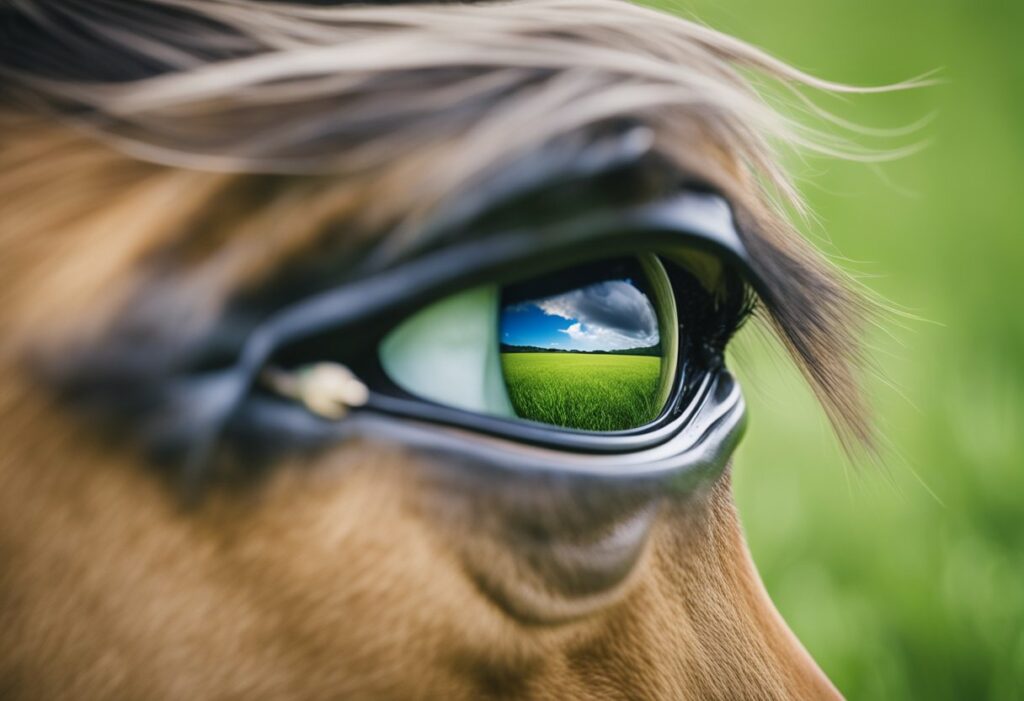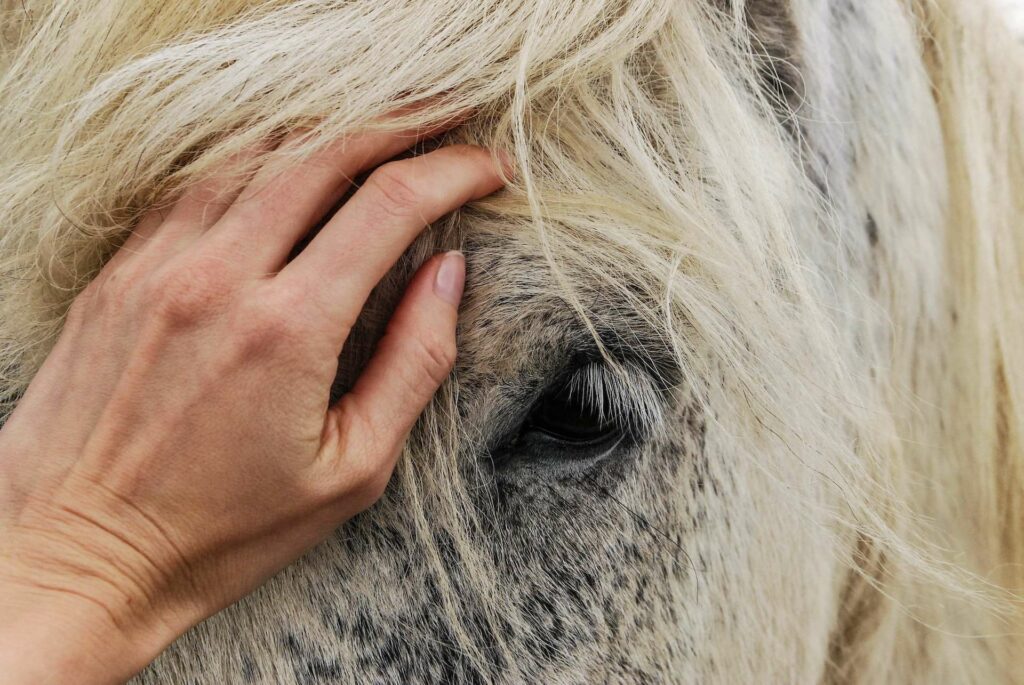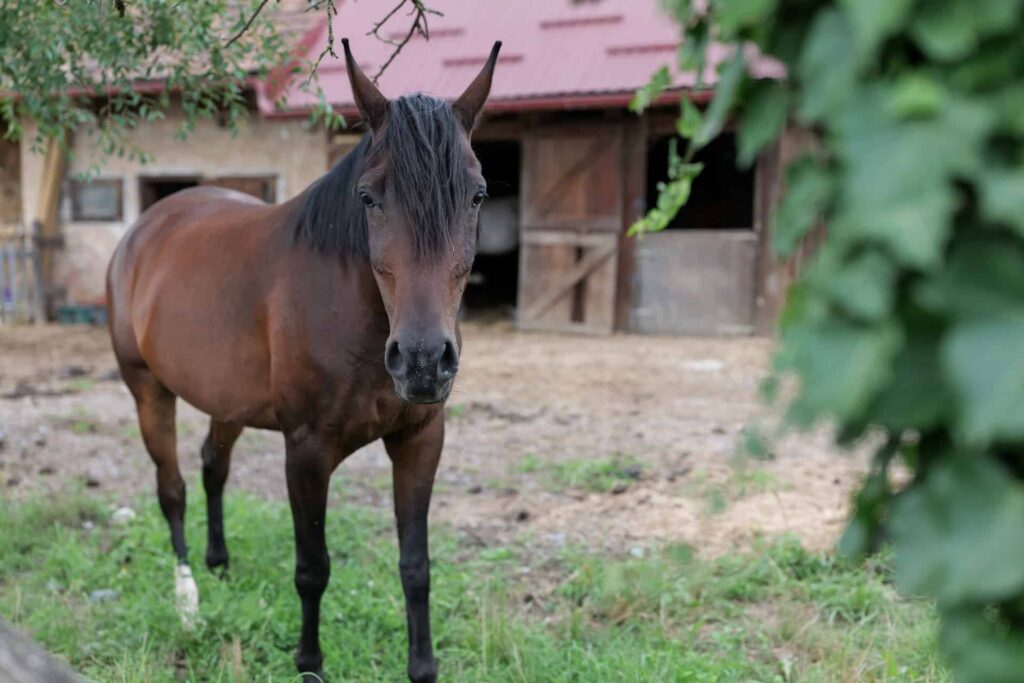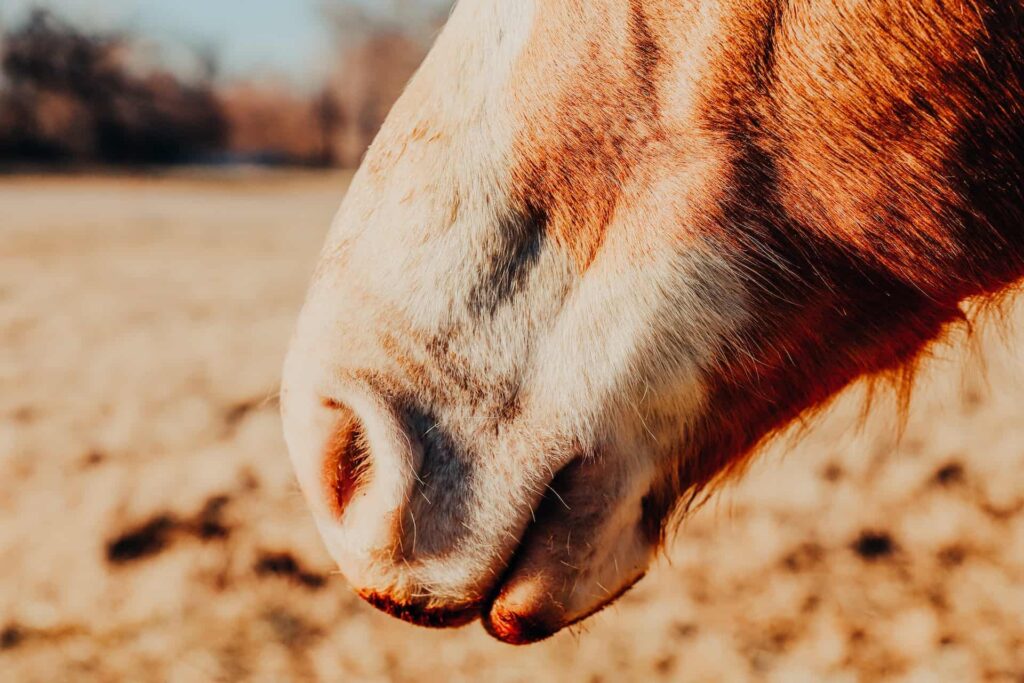Understanding horse vision is essential for anyone involved with equine care, training, or activities that involve horses. While human vision is often used as a benchmark, equine vision is different in many fundamental aspects. Horses have larger eyes compared to other land mammals, which is related to their need to detect motion in a wide range of environments. Their eyes are positioned on the sides of their heads, granting them a vast field of view, which is important for these prey animals to spot potential threats and predators of horses.
The anatomy of the equine eye allows for a certain visual acuity, albeit not as high as that of humans. Horses can detect motion over long distances and have a degree of binocular vision in front of them, which aids in depth perception. However, their monocular vision predominates, enabling them to see a wide expanse of their surroundings without having to move their heads. It’s also important to note that horses have dichromatic color vision, which is different from the trichromatic vision seen in humans, affecting how they perceive certain colors.
Key Takeaways
- Horses have a wide field of vision due to their side-positioned eyes.
- Equine vision is characterized by binocular and monocular viewing capabilities.
- Horses experience the world in dichromatic color, unlike humans’ trichromatic vision.
Anatomy of Equine Vision

The study of equine vision encompasses understanding the complex anatomy and functionality of the horse’s eye, which is distinctly adapted for their needs as prey animals. Specific features of their visual apparatus and photoreceptor mechanisms highlight how horses perceive their environment.
The Equine Eye Structure
The anatomy of the equine eye is remarkable for its large eyes, among the largest of any land mammal. These eyes are positioned on the sides of the head, affording horses a wide field of vision. The eyeball‘s outer layer, or sclera, is a tough protective sheath, while the cornea, at the front of the eye, admits light and begins the focusing process.
Just behind the cornea lies the iris and pupil, regulating the amount of light that enters the eye. The lens—positioned behind the iris—further focuses light onto the retina at the back of the eye.
- Nictitating membrane (third eyelid): A protective membrane that helps to clear debris from the surface of the eye.
- Corpora nigra: Irregular-shaped bodies attached to the edge of the iris that can be seen as dark spots when looking at a horse’s eye.
Unique to equine eyes, the tapetum lucidum reflects light through the retina, enhancing night vision. The ciliary body produces the aqueous humor and contains the muscles that adjust the curvature of the lens for near or distant focus. A portion of the inner eye, the choroid, provides oxygen and nutrients to the retina.
Visual Apparatus
In equine vision, both binocular and monocular views are utilized, each serving a distinct purpose. Binocular vision occurs when both eyes are used together, overlapping the visual field in front of the horse, which is vital for depth perception. In contrast, monocular vision allows horses to see different views on each side, expanding their overall visual field and enabling them to monitor a larger perimeter for potential threats. The blind spots of a horse are directly behind and immediately in front of them, areas where visual monitoring is impossible due to the eye positioning.
Photoreceptor Mechanisms
Within the retina, two types of photoreceptors—rods and cones—play critical roles in light detection and color vision. Horses possess a higher ratio of rods to cones, which supports superior vision in low-light conditions.
- Rods: Abundant in the equine retina, these are sensitive to low light levels and are primarily responsible for night vision.
- Cones: Although less numerous, cones enable color perception and are necessary for daytime vision.
The retina’s photoreceptors convert light into signals that are transmitted via the optic nerve to the brain, where these signals are interpreted as visual images. This intricate process allows horses to adeptly navigate their surroundings during both day and night.
Visual Capabilities
The visual system of a horse is highly adapted to its needs as a prey animal, characterized by a large field of vision and sensitivity to movement, albeit with certain trade-offs in depth and color perception.
Scope of Vision
Horses possess a broad field of vision due to the placement of their eyes on the sides of their heads. This allows for monocular vision on each side, granting them a wide range of peripheral vision. However, this eye position creates a blind spot directly in front of their noses and behind their heads. In contrast, their binocular vision, where the fields of vision overlap, is limited to a narrow area in front of them, aiding in depth perception of objects that are directly ahead.
Depth Perception and Distance
Horses have heightened depth perception in the area where their binocular vision is effective. While they can often focus on distant objects with ease, their depth perception degrades when objects are outside the binocular field, relying more on monocular cues. Coordinating information from both eyes, horses evaluate their surroundings to navigate and identify potential threats.
Color and Light Perception
Horses are believed to have dichromatic color vision, which means they can see blues and greens but have difficulty distinguishing between reds and greens. This type of vision is well-suited for detecting visual acuity in various lighting conditions. They can see in low light conditions better than humans, but their overall acuity is lower. Their eyes adjust to different light levels, enhancing their night vision capabilities for safety after dark.
Movement Detection
A horse’s ability to detect movement is a key aspect of its survival as a prey animal. They are particularly good at noticing peripheral motion, which alerts them to potential predators sneaking up from behind or the sides where their monocular vision reigns. This capability is critical for their flight response and overall safety, even if the visual field in which they detect said movement is not in sharp focus.
Ocular Health and Concerns
Maintaining ocular health in horses is critical for their performance and quality of life. Specific concerns such as disease prevention, timely examinations, and proper eye care are essential for equine vision health management.
Common Equine Ocular Diseases
Equine ocular diseases can have profound effects on a horse’s vision and overall health. Cataracts, characterized by the clouding of the eye’s lens, are a common concern and can lead to diminished vision or blindness if untreated. The conjunctiva, a membrane covering the eye, is susceptible to infections, causing discomfort and redness. The health of the lacrimal gland and nasolacrimal duct also plays a role, as these structures produce and drain tears, necessary for proper eye lubrication and protection from irritants.
Ophthalmology
Regular eye examinations by a qualified ophthalmologist aids in the early detection of ocular issues. An ophthalmologist is equipped to diagnose and treat conditions such as inflammation of the nictitating membrane—the horse’s third eyelid—which plays a significant role in eye protection. Expert management can include surgical intervention or medication, depending on the diagnosis. Such care ensures the health and retention of vision in affected horses.
Eye Protection and Maintenance
Practical management includes protecting the horse’s eyes from potential injuries and environmental hazards. The eyelids and nictitating membrane are natural protective mechanisms that block debris and excess light. Owners can complement these by using protective gear, such as fly masks, during turnout. Regular tear production is necessary for eye health, and any issues with tear ducts require prompt attention to prevent complications.
Vision and Equine Behavior
The intricate relationship between a horse’s vision and behavior significantly influences its interaction with the environment. A precise understanding of this interplay is crucial for ensuring the safety and appropriate management of these animals.
Behavioral Implications of Sight
Horses are prey animals, with eyes positioned on the sides of their head, providing a wide field of view to detect predators. This adaptation, however, creates significant blind spots directly in front and behind them, impacting their behavior. When an object suddenly enters these blind spots, horses may react with a spooking behavior. This is a survival mechanism, deeply ingrained in horses, which may lead to sudden, unpredictable reactions to unseen hazards in their environment.
Moreover, their relatively larger blind spots necessitate that handlers approach from angles visible to the horse to prevent startling them. The vision of horses is also adapted for detecting motion over long distances, which plays into their instincts as prey animals to be cautious and vigilant.
Environmental Interaction
In the context of environmental interaction, horses rely on their vision primarily for grazing and navigation. They possess a panoramic vision, allowing them to monitor their surroundings while their heads are down during grazing activities. However, their focus on distant movement can sometimes cause them to miss near hazards, making it vital to ensure their grazing environments are free from immediate dangers.
Furthermore, horses’ vision is not merely for predation avoidance; it also aids in social interaction and recognition of other horses. Recognizing subtle visual cues within the herd is critical for maintaining safety and social order. Handlers who understand the visual capabilities and limitations of horses can make more informed decisions about training, handling, and housing to accommodate the animal’s needs.
Adaptation and Training
Understanding how horses perceive their surroundings is essential for effective training and management. Their vision is a byproduct of adaptation to their environment, affecting their behavior and safety.
Equine Adaptation to Vision
Horses have evolved to have a wide field of vision, which allows them to detect predators with their excellent peripheral vision. This adaptation plays a role in their survival as prey animals. Their eyes are positioned on the sides of their head, granting them nearly 360-degree vision. Studies like “What horses and humans see: a comparative review” suggest that despite adaptations advantageous in low light, horses also benefit from color vision, which may aid in distinguishing their environment during their diurnal activity.
Training Considerations
When training horses, it’s essential to consider these visual adaptations. Vision significantly influences equine behavior and, by extension, training and safety outcomes. For example, abrupt changes in lighting may affect a horse’s visibility, as noted in the investigation of “Normal dark adaptation curve of the horse,” which could lead to training or safety issues.
Introducing horses to various lighting conditions systematically can be a part of their training regime. Additionally, an understanding of the “Importance of color vision in horses for management and training” ensures that visual cues used in training are within their color perception range, enhancing the effectiveness of the training.
Frequently Asked Questions
Exploring the intricacies of equine vision reveals significant differences from human vision, including a wide range of views and unique color perception abilities. Understanding these differences helps with effective handling and horse training.
How does a horse’s vision differ from human vision?
Horses have a wider field of view than humans and less depth perception directly in front of them. Compared to trichromatic human vision, horses likely see in a duotone color spectrum, making their perception of certain colors different from what humans experience.
What is the range of a horse’s vision, and how does it affect their perception of the world?
A horse’s vision encompasses nearly 350 degrees, with a slight blind spot directly in front and behind. This panoramic view allows horses to detect movement in a wide range but compromises their ability to see objects that are directly in front of them at close range.
In what ways do the physical attributes of horse eyes contribute to their visual abilities?
Horse eyes are among the largest of any land mammal, giving them a broad and highly sensitive visual field. This size and the position of their eyes on the sides of the head enhance their ability to detect motion, crucial for a prey animal’s survival.
What limitations do horses face with their vision, particularly on the sides?
Since horse eyes are located on the sides of the head, they have a monocular vision on each side, which can cause a loss of depth perception in these areas. Their depth perception primarily occurs in their binocular field of vision, which is smaller and centered towards the front.
Can horses perceive depth and distance similarly to humans, and how does this impact their interaction with their environment?
Horse and human abilities to judge distance and depth may be comparable, especially within the horse’s binocular vision field. However, understanding horses’ depth perception limitations is key to training and managing them safely.
Are horses able to discern colors, and if so, which colors can they see most clearly?
Horses can perceive colors, but not to the extent that humans can. They likely see blues and greens more clearly than reds, which can seem more muted or even greyish. Knowledge of color vision in the horse informs decisions about training and equipment selection to suit their visual capabilities.
Last Updated on December 14, 2023 by Nate Dewsbury



